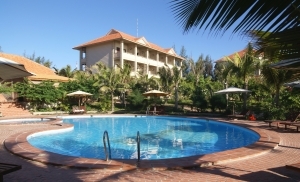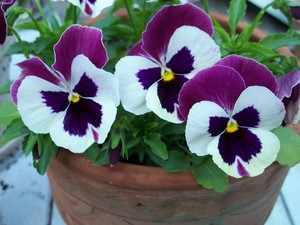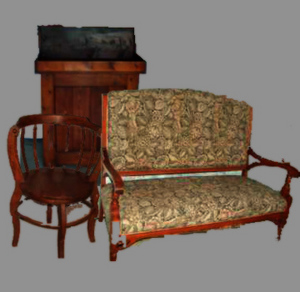Is There Such a Thing as a Blue Hibiscus? Perhaps you’re familiar with tropical hibiscus but what about blue hibiscus? Flowering tropical hibiscus come in a rainbow of colors including pink, white, red, peach, orange but not blue. Blue is a rare color in the plant world. There are not a lot of blue flowers like blue hibiscus compared to the volume of flowers in most colors. Blue is a prized color among gardeners, especially a blue hibiscus like “Blue Satin” because blue stands out beautifully in the landscape against green foliage and contrasts and complements most colors.
Blue Hibiscus Are Cold Hardy Hibiscus Shrubs Unlike tropical hibiscus, one great thing about Hibiscus syriacus “Blue Satin” is that it’s a shrub hibiscus that can be grown in areas which get cold winters. Once night time temperatures dip below 55 degrees Fahrenheit at night, tropical hibiscus need to be moved inside. Tropical hibiscus can be grown in zones 8 and higher while hibiscus “Blue Satin” is hardy in zones 5 through 8. I’ve successfully grown hibiscus syriacus “Blue Satin” in the Northeast in Washington, D.C. Although the flowers of “Blue Satin” look delicate, hibiscus syriacus is a hardy shrub which can withstand the extremes of cold, heat and humidity.
How Much Sun Does Hibiscus “Blue Satin” Require? Full sun. This means 4-6 hours of direct sun. Don’t even try it in part shade or part sun or if it’s partially obscured by tree shade for part of the day. Too much shade and you’ll probably end up with a green plant with tall stems reaching for the sun and very little flowering. Plant hibiscus syriacus “Blue Satin” in areas of your garden that get baking, hot sun. Despite its appearance, hibiscus “Blue Satin” can take the heat. Once established, shrub hibiscus is a drought tolerant plant that doesn’t need to be babied with a hose everyday. I’ve seen 8-10 foot tall hedges of hibiscus syriacus.
Why You Should Grow Hibiscus Syriacus “Blue Satin” Hibiscus syriacus “Blue Satin” is also known as “Rose of Sharon”. Like a rose, the hibiscus flowers of “Blue Satin” are absolutely gorgeous. Hibiscus syriacus “Blue Satin” flowers attract birds, hummingbirds, butterflies, bees and the shrub is deer resistant. The landscape value of hibiscus syriacus “Blue Satin” is its long lasting blooms from mid to late summer. At this time of year, many perennials that have long since bloomed in spring leave a void in the garden and that’s where hibiscus syriacus “Blue Satin” can provide much needed color.
How Big Does Hibiscus Syriacus “Blue Satin” Get? Hibiscus syriacus can eventually grow 8-12 feet tall. Hibiscus syriacus “Blue Satin” is a moderate grower, growing about a foot or so a year, more or less depending on soil and sun conditions and the maturity of plant you initially plant. Space hibiscus “Blue Satin” about 3 to 4 feet apart. Hibiscus syriacus “Blue Satin” can easily be grown as a flowering hedge which is gorgeous in the summer but not necessarily practical in the winter as it is deciduous and the plant will lose its leaves.
Can Hibiscus Syriacus “Blue Satin” be Grown as a Tree? Just like tropical hibiscus can be trimmed as a standard, hibiscus syriacus can be trimmed as a small flowering tree. Left alone, hibiscus syriacus will grow as a dense shrub. What size plant should you purchase? Hibiscus syriacus “Blue Satin” can sometimes be purchased in a 1 or 2 gallon size pot. I initially purchased my “Blue Satin” plant as an experiment in my community garden so I started with a small pot. However, it took a couple of years and looked awfully spindly before it really took off. So you may want to start with a 3 or 5 gallon size pot if you don’t have the time to wait for it to get established.
Hibiscus Syriacus “Blue Satin” is a “Proven Winner” “Proven Winners” are trademarked plants which undergo extensive testing, plant trials and are tested for hardiness, flowering and other variables before they’re introduced to gardeners. The company’s website actually slams another blue hibiscus shrub claiming hibiscus “Blue Satin” is “superior to ‘Blue Bird’, which is a weak growing plant.” From personal experience, I have not grown ‘Blue Bird” but I’ve found “Blue Satin” to be a great, easy care perennial flowering shrub with its only weakness being that it took a couple of years to get established which is not unlike most perennials and shrubs which flower better once their root systems develop.
Hibiscus Syriacus Plant Care Dig a hole twice as wide as the root ball. Water the hole. If the water does not drain, use a soil amendment like garden gypsum to help break up the clay soil. Loosen roots around the root ball and backfill the hole with soil amended with leaf compost. Also consider using triple phosphate or a root stimulating product which is optional but not necessary. I would consider using these products if you are planting during the summer to help get the shrub established quickly. Lightly mulch. Water every few days as needed, watering thoroughly and deeply then gradually less frequently so the shrub establishes deep roots.
Hibiscus Syriacus Care Year Two, Three & Beyond In the Spring, feed with a slow release fertilizer like Espoma Plant Tone and a light mulch of leaf compost. It is not necessary to prune or deadhead plants but if you want to stimulate branching, you can prune in the fall after blooming or do light renewal pruning in early spring before buds are established.






